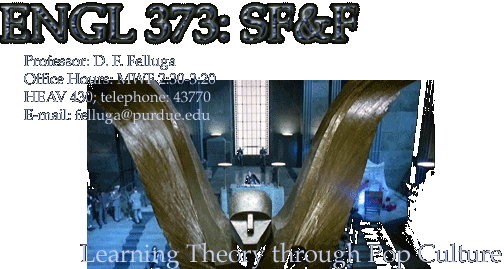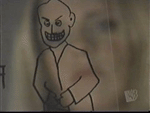

Course Description
This course will posit that speculative fiction (specifically, the speculative fiction one finds on television and film) represents one of the only still viable generic forms that deals with the present in an allegorical form. Starting from this premise, we will address a number of issues in contemporary culture through the popular science fiction and fantasy works we will be viewing, specifically postmodernism, our contemporary carceral culture, politics and power, and late capitalism. The course will also serve as an introduction to the major theories currently influencing English studies: narratology, theories of gender and sex, postmodernism, theories of ideology, and psychoanalysis. As such, the course will use my web-based Guide to Theory as one of its primary texts: http://www.purdue.edu/guidetotheory. I will suggest that speculative fiction gives us a special access to the ways we make sense of the world in our everyday lives. By pushing to the limits such issues as subjectivity, temporal sequentiality, and representation, speculative fiction can uncover the ways ideology, narrative, and epistemology function on a day-to-day basis. In short, as we progress through the semester, we will be taking both science fiction and pop culture seriously, and will consequently be dealing with a number of "serious" issues that concern us in our contemporary culture.
 |
||
| Guide
to Theory
|
||
| Modules: |
||
| |
||
| Definitions:
|
||
| |
||
| Introductions: |
||
| |
||
| Class
Web Site
|
||
| Synopses: |
||
| |
||
| Primers: |
||
| |
||
| Jump to
Date: |
||
| |
||
| REQUIRED TEXTS | RESOURCES | |
| Course Readings (available as pdf downloads) |
Boilercast of this class (click on 'BoilerCast File Access') |
|
| Course Web Site and Guide to Theory (available here) |
Purdue On-Line
Writing Lab (OWL) |
|
| The episodes and films listed below (also available at HIKS Reserves) |
OWL's
Guide to using MLA Format in Citation |
|
| Sample Mid-Term Questions |
||
Best Responses from the Spring '03 Mid-Term |
||
| Best Responses from the Fall '03 Mid-Term |
||
| Examples of Incorrect Grammar and Style |
||
'A' Papers from Spring 2003:
|
||
A Sample Final Exam (in pdf format) |
| GRADE DISTRIBUTION | ||
| 20%—Class Participation | 25%—Final Paper | |
| 15%—Mid-Term | 25%—Final Exam | |
| 15%—First Paper | ||
| COURSE POLICIES |
| Click Here |

 CELL ONE:
CELL ONE:
FILL IN THE X; OR, THE ABCs OF NARRATOLOGY

In these first weeks, I will introduce students to the basic structures of narrative form, specifically the distinction between "story" and "discourse" and between the "proairetic and hermeneutic codes" of narrative. Students will also begin to analyze film, thus becoming familiar with those terms from film theory that we will build on over the course of the semester. A number of pop cultural shows and one experimental film (La jetée) will serve to help us in our exploration of the narrative limitations of human consciousness.
Star Trek: TNG, "Cause and Effect" TNG, "Cause and Effect" Definition of "story and discourse" Definition of "proairetic and hermeneutic codes" Primer on Star Trek: The Next Generation
Star Trek: TNG, "Cause and Effect" TNG, "Cause and Effect" Material from Wednesday Synopsis of Class: August 25-29, 2008
No class: Labor Day
Chris Marker, La jetée Chris Marker, La jetée Constance Penley, The Future of an Illusion 126-139 Terms applied to the analysis of film Brooks Module on Plot Brooks Module on Narrative Desire
Chris Marker, La jetée Garrett Stewart, Between Film and Screen 102-105, 293-298 Brooks Module on Plot Brooks Module on Narrative Desire Synopsis of Class: September 1-5, 2008
X-Files, "Clyde Bruckman's Final Repose" X-Files, "Clyde Bruckman's Final Repose" Peter Brooks, Reading for the Plot 94-112 Primer on X-Files, "Clyde Bruckman's Final Repose" Terms used in the analysis of film (eg. POV shot, etc.)
X-Files, "Clyde Bruckman's Final Repose" Terms applied to the analysis of film (eg. POV shot, etc.) Brooks Module on Plot Brooks Module on Narrative Desire
X-Files, "Clyde Bruckman's Final Repose" Terms applied to the analysis of film (eg. POV shot, etc.) Brooks Module on Plot Brooks Module on Narrative Desire Synopsis of Class: September 8-12, 2008 Information about the hidden references in "Clyde Bruckman"
X-Files, "Jose Chung's From Outer Space"
Brooks Module on Transference Freud Module 5 on Trauma and Transference Definition of "frame narrative"
X-Files, "Jose Chung's From Outer Space"
Brooks Module on Transference Freud Module 5 on Trauma and Transference Definition of "frame narrative" Synopsis of Class: September 15-19, 2008

 CELL TWO:
CELL TWO:
PSYCHOANALYSIS, FEMINISM, AND THE VAMPIRE SLAYER

In this next block of classes, we will build on our discussion of Brooks by continuing our exploration of psychoanalytical concepts, specifically those of Sigmund Freud, Jacques Lacan, and Julia Kristeva. Througout, Buffy will be our guide since Joss Whedon, the show's creator, self-consciously incorporates both Freudian and Lacanian elements into his Buffyverse.We will also take this opportunity to discuss the influence of Lacan on both feminism and contemporary film theory.
Buffy, "Restless" Sigmund Freud, "The Uncanny" 120; 136-153 Freud Module on Psychosexual Development Freud Module on the Unconscious Freud Module on Repression Freud Module on Neuroses
Buffy, "Restless" Freud Module on Psychosexual Development Freud Module on the Unconscious Freud Module on Repression Freud Module on Neuroses Synopsis of Class: September 22-26, 2008
Buffy, "Hush" Slavoj Zizek, Looking Awry 6-8, 12-25, 39-43 Lacan Module on Psycho-Sexual Development Lacan Module on the Structure of the Psyche Lacan Module on Desire
Buffy, "Hush" Lacan Module on Psycho-Sexual Development Lacan Module on the Structure of the Psyche Lacan Module on Desire Synopsis of Class: September 29-October 3, 2008
Buffy, "Once More, With Feeling" Judith Butler, "Performative Acts and Gender Construction" Butler Module on Gender and Sex Butler Module on Performativity
Buffy, "Once More, With Feeling" Material from this week Synopsis of Class: October 6-10, 2008
No Class: October Break
Class Canceled
In-Class Mid-Term
Be sure to bring blue books to the exam
Buffy, "The Body" Slavoj Zizek, Looking Awry 88-97, 104-106 Definition of "between the two deaths"
Buffy, "The Body"
Note: First Paper is Due TodayMaterial from this week Synopsis of Class: October 20-24, 2008
 CELL THREE:
CELL THREE:
SCIENCE FICTION AND THE POSTMODERN CONDITION 
In this next block of classes, we will examine a number of science-fiction examples that explore our current age, which has been termed by many "postmodernity." We will explore the various elements of our current "postmodern condition," including computer culture, image culture, media culture, pop culture, and multiculturalism. Alongside the films, we will be reading some of the most influential postmodern theorists of the last decade. In so doing, we will explore a number of concepts that have been used to understand our age, including pastiche, parody, the simulacrum, and the cyborg.
Ridley Scott, Blade Runner Slavoj Zizek, Tarrying with the Negative 9-12; 40-41
Andy and Larry Wachowski, The Matrix Andy and Larry Wachowski, The Matrix Jean Baudrillard, "The Precession of Simulacra" 1; 2-3; 4-5; 12-13; 14-15 Baudrillard Module on Postmodernity Baudrillard Module on Simulation
Andy and Larry Wachowski, The Matrix Baudrillard Module on Postmodernity Baudrillard Module on Simulation Synopsis of Class: November 3-7, 2008
X-Files, "The Postmodern Prometheus" Material from Monday Synopsis of Class: November 10-12, 2008
Class Canceled
Terry Gilliam, Brazil Material from this week Synopsis of Class: November 17-21, 2008

TEMPORAL RIFT: THANKSGIVING BREAK
NO CLASS ON NOVEMBER 24-28

 CELL FOUR:
CELL FOUR:
THEORIZING FIGHT CLUB 
In this last section, we will apply the various theories we have learned on David Fincher's film, Fight Club. The film invites a reading through each of the theories discussed so far: Narratology, Psychoanalysis, theories of gender and sex, Postmodernism, and theories of ideology. By applying each of the theories discussed this semester, these next weeks will serve as hands-on practice for the final exam.
David Fincher, Fight Club David Fincher, Fight Club Material on Foucault and Althusser
David Fincher, Fight Club
Note: Final Paper is Due TodayMaterial on Baudrillard and Introduction to Postmodernism
David Fincher, Fight Club Material on Jameson and Hutcheon
David Fincher, Fight Club Material on Butler, Mulvey, and Introduction to Gender and Sex
David Fincher, Fight Club Material on Zizek, Kristeva, Lacan, Freud, and Psychoanalysis
David Fincher, Fight Club Material on Brooks, Barthes, and Narratology Synopsis of Class: December 1-12, 2008
Final Exam from 8-10am in HEAV 101
Be sure to bring blue books to the exam

Introductory Guide to Critical Theory
Last Revised: December 9, 2008
gif images courtesy of
Media Builder